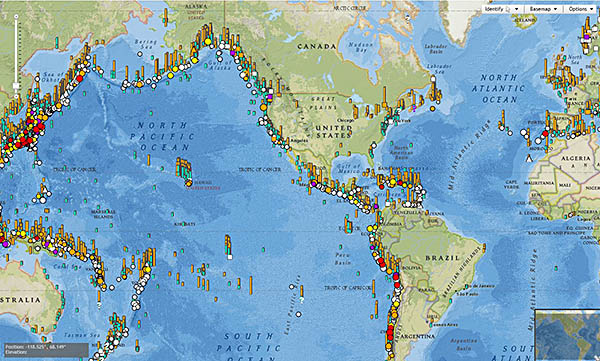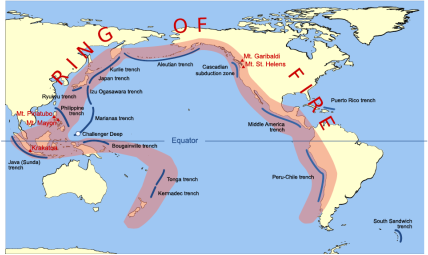Tsunamis can be generated in all of the world's oceans, inland seas, and in any large body of water. They have caused damage and deaths in coastal areas all around the world and can strike any coast.
However, certain areas are particularly prone to tsunamis and the devastation they can bring. This is due to their location near local tsunami sources, exposure to distant tsunami sources, and local bathymetry and topography.
- 78% Pacific Ocean (around the geologically active "Ring of Fire")
- 9% Atlantic Ocean and Caribbean Sea
- 6% Mediterranean Sea
- 5% Indian Ocean
- 1% Other Seas
The highest percentage of these tsunamis was generated off Japan (20%), followed by Russia (8%) and Indonesia (8%). While most tsunamis are small and nondestructive or only affect coasts near their source, some tsunamis can cause damage and deaths on distant shores. The most significant distant tsunamis since 1900 originated off Alaska, Chile, Japan, Indonesia, Pakistan, and Russia.


This is the most volcanically and seismically active zone in the world. It extends from Chile, northward along the South American coast through Central America, Mexico, the West Coast of the United States, and the southern part of Alaska, through the Aleutian Islands to Japan, the Philippine Islands, New Guinea, the island groups of the Southwest Pacific, and to New Zealand.
According to the U.S. Geological Survey, 90% of all earthquakes and 81% of the largest earthquakes happen along this "ring," where the Pacific plate meets its surrounding plates.
An assessment of the tsunami hazard in the United States shows that while a tsunami can strike any U.S. coast, the hazard level varies. The hazard levels shown below are based largely on the historical record (through 2014), geological evidence, and location relative to tsunami sources, all of which provide clues to what might happen in the future.
Note: Historical records are brief and incomplete. Events may have been unreported or underreported or may have happened in unpopulated areas and gone undetected.
While a distant tsunami could strike any U.S. coast, the hazard is greatest for those near subduction zones, where large earthquakes and associated landslides can produce damaging waves that threaten nearby and distant coasts, like those around the Pacific and Caribbean.
The U.S. Atlantic and Gulf Coasts are not near subduction zones, and earthquakes off and along these coasts are not as large or as frequent as in other regions. The most likely tsunami sources for these coasts are submarine landslides and weather (which can generate meteotsunamis).
| Location | Risk | Earliest Reported Event | Total Events | Events with Runups > 1 m (3 ft) |
Damage Total (2017 dollars) |
Deaths |
|---|---|---|---|---|---|---|
| Alaska | High to Very High | 1737 | 100 | 22 | $717 million | 222 |
| Hawaii | High to Very High | 1812 | 134 | 30 | $668 million | 293 |
| U.S. West Coast | High to Very High | 1812 | 94 | 17 | $252 million | 25 |
| American Samoa | High | 1837 | 68 | 4 | $143 million | 34 |
| Guam and Northern Mariana Islands | High | 1849 | 25 | 4 | 0 | 1 |
| Puerto Rico and the U.S. Virgin Islands | High | 1690 | 13 | 4 | $62 million | 164 |
| U.S. Atlantic Coast | Very Low to Low | 1886 | 8 | 0 | 0 | 0 |
| Alaska Arctic Coast | Very Low | None | 0 | 0 | 0 | 0 |
| U.S. Gulf Coast | Very Low | 1918 | 1 | 0 | 0 | 0 |
| Runup is the maximum elevation of the tsunami flooding on shore. Tsunamis with runups over one meter (~3 feet) are particularly dangerous to people and property, but smaller tsunamis also pose threats. | ||||||
Take it to the MAX! Cascadia Subduction Zone


